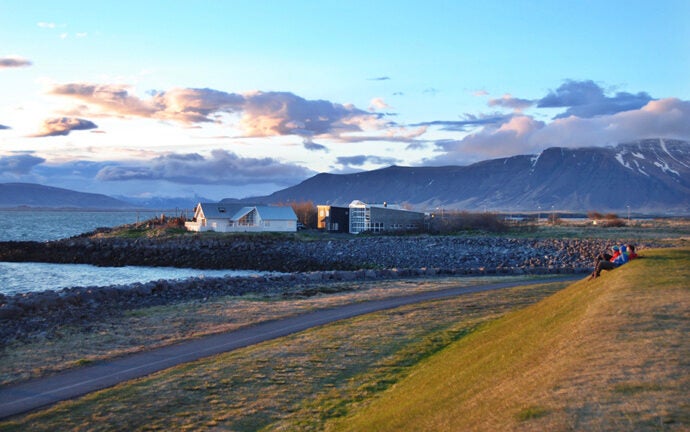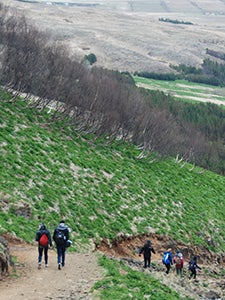
Exploring Arctic Issues
Perched 420 meters above sea level, USC Dornsife undergraduate Kathryn Kelly surveyed a stunning landscape of fjords, islands and white-capped mountains. Spread at her feet, like a jewel in the crown, lay one of the world’s most northerly communities, the Norwegian city of Tromsø — dubbed the “capital of the Arctic.” It was a beautiful June evening. And although it was late — after 11 p.m. — Kelly could see everything in perfect detail because the midnight sun was shining.
In her post-course reflection, she wrote, “I could shout at the top of my lungs and not penetrate the Arctic silence. Only at this precise moment did I fully comprehend the urgency and importance of the need to preserve this region of untainted beauty.”
Kelly, a sophomore majoring in international relations and English, was one of 17 USC Dornsife undergraduates who traveled to Norway, Iceland and Finland from May 27 to June 4 as part of the Problems Without Passports (PWP) course “Ecological Security and Global Politics.”

Eric Hahn, Isabella Soehn and Vanessa Alderete exploring Tromsø, the largest city in northern Norway.
Led by Steven Lamy, professor of international relations and vice dean for academic programs, the course furthered students’ understanding of the implications of climate change in the Arctic through hands-on experiences and meetings with experts.
“There are more than four million people living in the Arctic region for whom climate change creates domestic issues,” Lamy said. “For the rest of the world, the Arctic represents a region suffering from environmental degradation caused by our consumer economy. As the region warms it may suffer more from pollution, unsustainable economic growth and conflicts over resources and control of critical territory.”
A complex but cohesive view
Austin Reagan, a senior majoring in environmental studies, said meetings with experts on the region during the course had enhanced his curiosity and served to magnify the importance of the Arctic in his understanding of world affairs.
“Professors, diplomats, researchers, activists and everyday citizens helped us to piece together a [complex] but cohesive look at the Arctic,” he wrote in his reflection. “Further inquiry on our own initiative allowed us to conduct individual research … Visits to cities both large and remote reinforced a full perspective, skewed towards neither the urban nor the rural.”
Reagan now understood that, just as the Arctic links interests of governments near and far, the complexity of the region requires the coming together of many fields and disciplines to mold an accurate impression.
“What we’re seeing play out in the Arctic today is just the tip of the iceberg. I realize now that any consideration of our common future, whether we intend to define it as sustainable or secure or profitable or livable, must place Arctic issues at the center.”
“A truly privileged space”
Isabella Soehn, a junior majoring in international relations and mathematics/economics, revealed she knew very little of the issues involved before taking the course.
“Now I occupy a truly privileged space,” she wrote. “Through interviews with [a diverse range] of people concerned with the Arctic region … this trip has given me a breadth in perspective I don’t think can be [absorbed] from a book.”

Steven Lamy, professor of international relations and vice dean of academic programs, led the PWP course.
Describing the PWP as “an incredibly valuable experience,” Hanna Jolkovsky, a senior majoring in international relations and history, added that the course “provided a unique and incredible opportunity …
“I have certainly read about and studied the ‘cooperative’ nature of the Nordic states, but I did not understand, or fully appreciate, how special this kind of political culture is. Just the fact that we were able to talk to so many high-level diplomats and researchers showed how open and close their society is.”
Students agreed the course reinforced their belief in the importance of visiting and experiencing other cultures in order to gain a better understanding of a people and their history.
“I don’t believe there is a more valuable way to engage students to apply what they learn in class or provide them with a way to gain confidence in their own voice,” wrote Kelly. “I leave this program knowing that I am better equipped to ask questions that matter and with a newfound confidence to share my voice with the world.”
Preparation, a full agenda and some exploration
Before leaving for the Arctic, students attended lectures at USC Dornsife given by Will Berelson, professor of earth sciences and environmental studies, and chair of earth sciences, and Julien Emile-Geay, assistant professor of earth sciences, to introduce them to the basics of climate science and the impact of climate change on the region.
Additional preparatory classes focused on understanding foreign and domestic politics of the Arctic states and exploring institutions involved in governance of the region. Students read about policy challenges faced by citizens and political leaders in the Arctic and the impact of these challenges on the rest of the world.

Students were able to get a first-hand experience of the Icelandic landscape during a day-long hike outside Reykjavik.
The first destination was the Icelandic capital, Reykjavik, where students toured the parliament, heard presentations at the University of Iceland on equality and gender in the Arctic, and Icelandic security and defense policy, and attended briefings at the Icelandic Foreign Ministry and the U.S. Embassy.
Divided into research groups, students worked to set up interviews with professors, public officials and business leaders. One group secured a two-hour meeting with the Russian ambassador to Iceland.
In Akureyri in northern Iceland, students attended lectures at Akureyri University and participated in a roundtable discussion with the U.S. and Canadian ambassadors on critical Arctic issues and the future Arctic Council agenda under U.S. leadership.
In the Norwegian capital Oslo, students visited the parliament and learned about Norwegian Arctic policies, attending lectures at the Norwegian Institute for International Affairs, the World Wildlife Fund and the Fridtjof Nansen Institute. In Tromsø, students learned about knowledge and technology as sources of power in the Arctic region, and met with Magnus Johannesson, administrative director of the Arctic Council.
In Inari, Finland, students visited the Sami parliament and learned about Sami human security issues and governance and cooperation among the various Sami groups in the Arctic region.
The course concluded in Rovaniemi, Finland, where each student research group presented their final paper at the University of Lapland.
However, the course wasn’t all work and no play. In addition to exploring each city and visiting museums, universities and other cultural institutions, students also got a taste of the Icelandic landscape during a day-long hike outside Reykjavik. An eight-hour bus journey through spectacular countryside from Tromsø to Inari enabled them to see reindeer, fjords, birch and evergreen forests — and even glimpse views of Sweden and Russia.